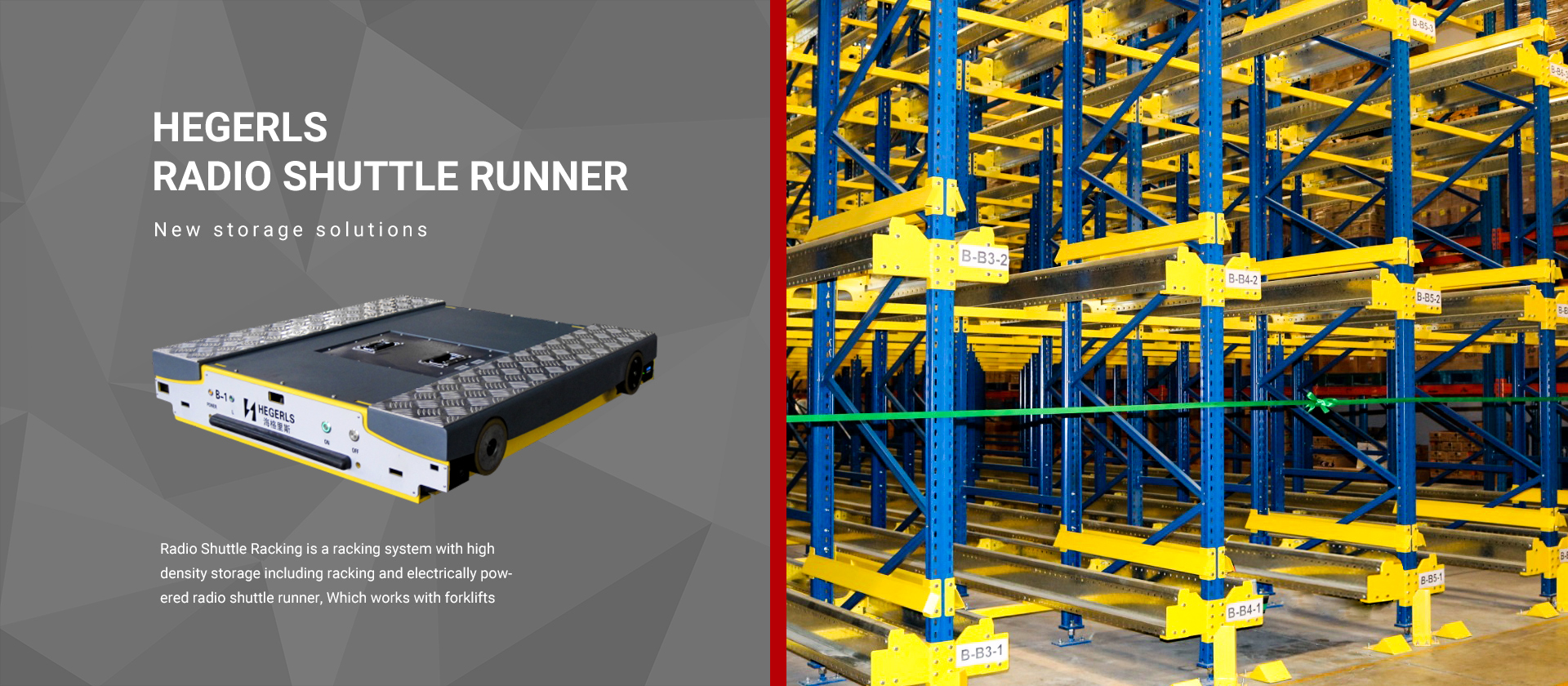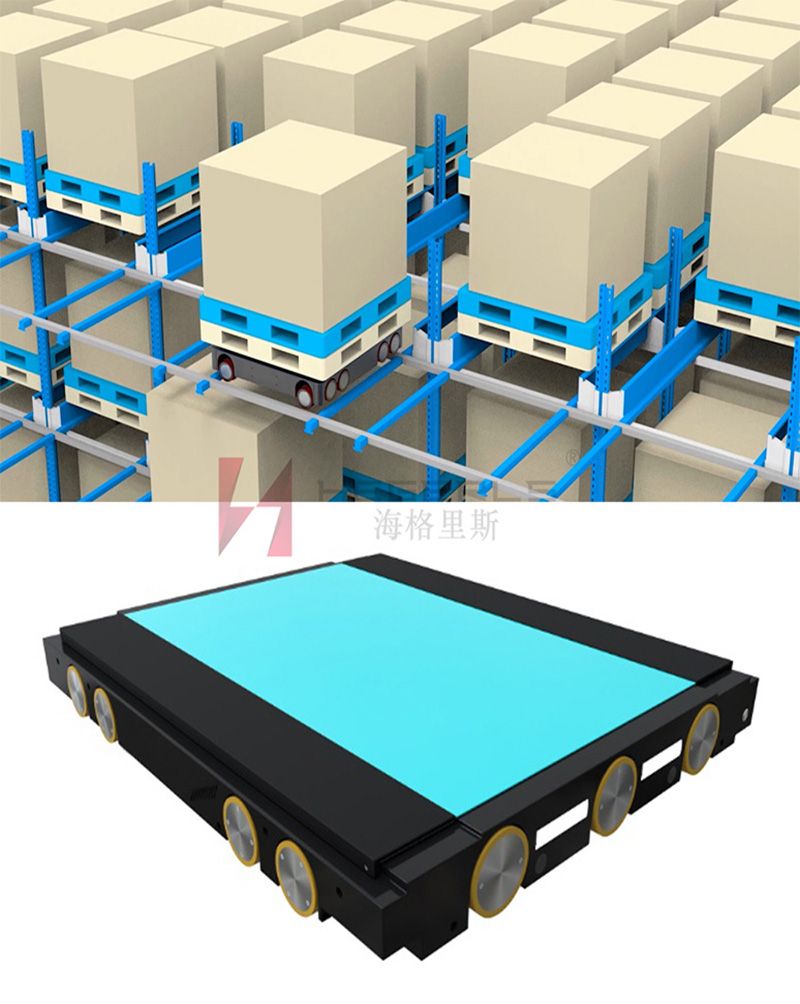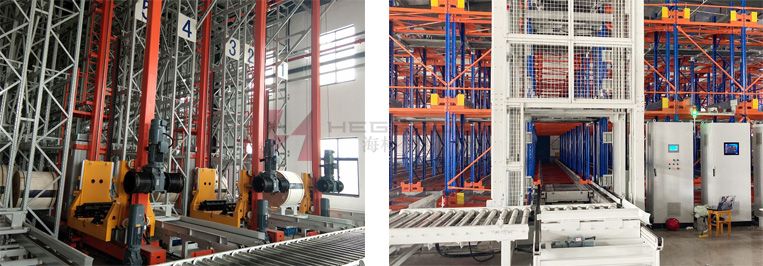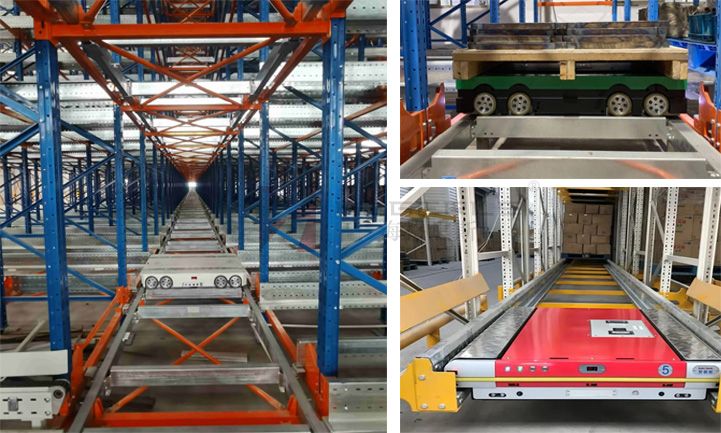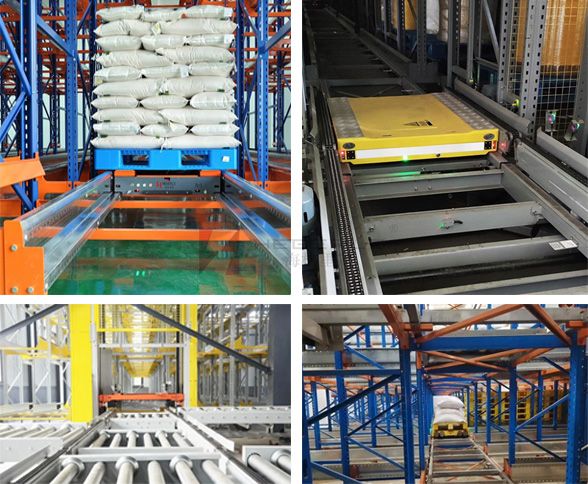With the rapid development of the modern logistics industry, the four-way shuttle vehicle three-dimensional warehouse has become one of the mainstream forms of automated three-dimensional warehouses due to its advantages in efficient and dense storage functions, operating costs, and systematic intelligent management in the warehousing system.
The four-way shuttle car three-dimensional warehouse is a type of automated three-dimensional warehouse, consisting of a four-way shuttle car, three-dimensional shelves, elevators, tray conveyor lines, lifting and transferring machines, and a software control system. The shelf section is used to store goods, the four-way shuttle is used to transport goods on the shelf, and the software control system is used to control the operation of the four-way shuttle and other automation equipment, and record the actual situation of the goods. The four-way shuttle car three-dimensional warehouse is a common automated three-dimensional warehouse solution that can be applied to irregular, irregular, large aspect ratio or small variety large batch, multi variety large batch warehouses. By utilizing the vertical and horizontal movement of the four-way shuttle car and cooperating with the elevator for layer changing operations, automated storage and retrieval of goods can be achieved, which is suitable for low flow and high density storage as well as high flow and high density storage. The four-way shuttle three-dimensional warehousing system is a new type of intelligent warehousing system that integrates multiple functions such as automatic stacking, automatic handling, and unmanned guidance. With the rapid development of warehousing logistics and e-commerce industries, it has been widely applied.
The three-dimensional warehouse of four-way shuttle cars is more complex in control scheduling, order management, route optimization algorithms, and other aspects, making project implementation more difficult. Therefore, there are relatively few suppliers, and Hebei Woke Metal Products Co., Ltd. (self owned brand: HEGERLS) is one of the few suppliers.
Compared to manual warehouse shelf storage and shipment, the four-way shuttle solution has evolved the flat “goods to people” system into a multi-layer 3D “goods to people” system, creating an automated three-dimensional warehouse with higher and denser storage spaces. The HEGERLS four-way shuttle three-dimensional warehouse solution is suitable for the storage of vehicle specifications such as pallets, bins, and cardboard boxes, and is suitable for various complex spatial layouts and industry scenarios. In the same spatial layout system, the HEGERLS four-way shuttle vehicle three-dimensional warehouse system has a higher degree of automation and stronger inbound and outbound processing capabilities compared to traditional warehousing systems, which can greatly shorten task processing time.
Operation process of HEGERLS four-way shuttle car three-dimensional warehouse
1) Storage: The storage tray is directly placed at the storage port through a forklift, and after pressing the storage button, the conveyor line moves in the direction of storage. After appearance inspection, inspect whether the goods are placed properly. If they are qualified, they will be stored and scanned with barcodes; If it is not qualified, it will be returned to the warehouse and the goods will be manually rearranged. The barcode scanner scans the pallet code. After successful scanning, WCS (control system) feeds back the barcode value to WMS. WMS (computer management information system) assigns the cargo location based on the barcode value and sends it to WCS (including information such as the number of layers, rows, columns, and depths of the cargo location); WCS sends the received cargo location information to the PLC; The PLC controls the operation of the conveyor line by obtaining the destination address for storage; Simultaneously control the hoist to transport goods to the destination layer. If the scanner fails to scan the code, WCS will provide feedback to WMS on the result of the scan failure, and the conveyor line will stop running and wait for manual processing; If the scan value is determined by WMS to be invalid, the conveyor line will stop running and wait for manual processing; Operators can use handheld terminals to scan codes again or replace barcode information to handle abnormal scanning situations. If the goods need to be returned for processing, press the “return button” at the storage port, and the goods will be returned to the storage port for processing.
2) Stop waiting for the goods to move to the conveyor line at the elevator entrance; The PLC confirms the number of shelf layers that the goods need to reach based on the destination address for storage, and calls the elevator. When the elevator reaches the first floor, the conveyor line transports goods to the elevator, and the goods pass through the elevator to reach the destination floor; After the elevator reaches the destination layer, the goods exit the elevator along with the elevator conveyor line and wait for the shuttle truck to pick up the goods at the pick-up port.
3) WMS (Computer Management Information System) sends inbound tasks on a regular basis, and WCS (Control System) receives the inbound tasks and issues them to the destination shuttle vehicle of the goods; The shuttle receives the inbound instructions, drives to the destination level pickup port to pick up the goods, and transports them to the destination cargo location. WMS (Computer Management Information System) issues one task at a time, and WCS (Control System) executes inbound and outbound tasks based on the order of tasks issued by WMS (Computer Management Information System). Before WMS (Computer Management Information System) issues inbound tasks, it is necessary to determine whether the outbound task has been completed; After the completion of the outbound task, the inbound task is issued to prevent deadlock caused by the occupation of conveyor line resources.
4) Outbound: WMS (Computer Management Information System) issues outbound tasks (including start address and destination address) to WCS (Control System). After WCS (Control System) receives the outbound task, the outbound goods are transported by the shuttle car on the current level of the goods to the elevator conveyor line; The goods stop waiting on the conveyor line at the elevator entrance, while the PLC controls the elevator to reach the current level of the goods; After the elevator reaches the current level of the goods, the conveyor line transports the goods to the elevator. The elevator carries the goods to the first level, and the goods exit the elevator. The conveyor line transports the goods to the exit port. Manually remove the tray and complete the outbound process.
5) Warehouse entry, exit, and transfer (move out, move in) locations are assigned by the WMS system, and the warehouse control system does not support assigning locations; If there is a tray blocking the intelligent shuttle vehicle during its travel path, WMS needs to first issue a warehouse transfer task and remove the blocking tray before issuing subsequent tasks.
6) The automatic control system (WCS) executes tasks in the order of their received time, with the tasks received first being executed first.
7) WMS (Computer Management Information System) issues tasks on a regular basis, and after prioritizing them internally, WCS issues a single task each time.
8) The execution efficiency of automation equipment is closely related to the order in which goods are stored and placed, as well as the method of leaving the warehouse and the depth of the tunnel. These methods determine the actual efficiency of the final automation equipment. The efficiency of automation equipment is based on the efficiency obtained under the premise of operating in the above scenario.
9) If a shuttle car on a certain layer malfunctions, after manually confirming the fault information, the faulty vehicle can be moved to a location that does not affect the inbound and outbound paths. Idle vehicles on other layers can be lifted and replaced to the faulty vehicle layer to perform tasks.
Hebei Woke, as a well-known manufacturer with relevant equipment technology patents, has invested a large amount of funds in the research and development and upgrading of related intelligent equipment technology every year. Its own brand HEGERLS factory has automated production lines and intelligent management, and has now gone global. It has been trusted by many customers in countries and regions such as Europe, America, the Middle East, Latin America, and Southeast Asia, and has independently designed and produced intelligent shuttle cars Multilayer shuttle cars, parent-child shuttle cars, four-way shuttle cars, and tunnel stackers have become designated automated three-dimensional warehouse equipment brands for many enterprises.
Post time: May-15-2023

